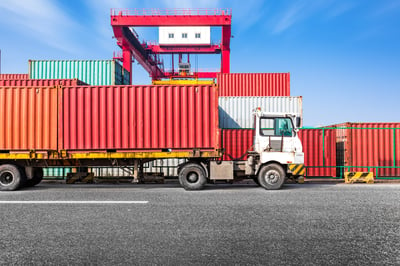Explainer: What is drayage?
At Cole International, we believe that the more you know, the better your goods will go. Our Explainer posts provide valuable information you should know before you make your next move.
We understand that the logistics industry involves complex processes, regulations, and definitions that can be overwhelming to navigate. Cole's Explainer series breaks down key concepts into bite-size knowledge that's easy to consume.
In this Explainer, we’ll examine the drayage process, different types of drayage, the benefits of drayage, and what to look for when selecting a drayage partner.
Drayage is a critical link in the supply chain
Every link in your supply chain represents a critical step toward a successful delivery. Drayage is no exception. When your container arrives at a port facility, drayage will often be the next step to get goods moving toward the destination.
A vital part of the supply chain for centuries, drayage has evolved alongside technological advancements. The origin of the term “drayage” can be traced back to the use of horse-drawn carts that were called “drays”. Drays transported goods over short distances, similar to how trucks and other vehicles perform this crucial logistics function.
What is the drayage process?
Drayage may seem like a straightforward process that moves goods over short distances. On closer inspection, drayage can involve a complex network of service providers, regulations, costs, international shipping challenges, and technological advancements that need to be carefully managed to ensure successful outcomes.
Drayage companies take responsibility for moving shipping containers and cargo from the port to nearby warehouses, fulfillment centres, and distribution centres. As such, drayage companies play a key role in managing the movement of your goods through the supply chain.
Types of drayage shipping services
There are several types of drayage services available. Here's a look at the three primary types:
- Intermodal drayage involves the transportation of shipping containers that are designed to be moved between different modes of transportation, such as rail, truck, and ship.
- Container drayage refers to the transportation of containers between ports and distribution centers.
- Specialized drayage describes the transportation of oversized or specialized cargo, such as heavy machinery or hazardous materials. These types of shipments require specialized equipment, permits, and regulatory compliance.
The definition of drayage shipping types expands when considering the viewpoint of the Intermodal Association of North America (IANA). According to the IANA, six different categories of drayage exist:
- Cross-town drayage: Also referred to as “inter-carrier”, this type of drayage moves intermodal units from one railroad to a different carrier’s railroad.
- Door-to-door drayage: This category refers to retail goods moved over the road from the port to a customer location.
- Expedited drayage: When time-sensitive freight must move, companies perform expedited drayage to ensure timely deliveries.
- IMX drayage: Also referred to as “intra-carrier”, this type of drayage describes the movement of intermodal units from one railroad hub to an intermodal hub operated by the same carrier.
- Pier drayage: This refers to intermodal units moved over the road from a rail hub to a seaport.
- Shuttle drayage: When space is at a premium, carriers shuttle goods and containers from busy hubs to empty lots to free up space for additional freight arrivals.
Regardless of the type of drayage performed, importers and exporters rely on short-term haulage to reduce delays for intermodal deliveries of goods.
Benefits of drayage
Drayage services play a crucial role in ensuring the smooth and efficient flow of goods through the supply chain, enabling quick and cost-effective movement of cargo between different modes of transportation. Drayage can minimize transit times and reduce transportation costs.
Additional benefits of outsourcing to experienced drayage firms include cost savings, improved efficiency, and reduced carbon emissions due to minimized traffic congestion and idling.
Drayage costs are influenced by variables such as distance, weight, and the type of goods hauled. Insurance, fuel surcharges, and compliance can also increase the cost of drayage. Detention and demurrage fees may apply when containers and cargo aren’t picked up or delivered within an agreed-upon timeframe.
These costs can be managed by negotiating rates with service providers, optimizing shipment volumes to reduce per-container costs, and monitoring performance metrics to discover areas of improvement.
Things to consider when working with a drayage company
In addition to short hauls, drayage companies also provide services such as cargo tracking, documentation management, and managing the movement of goods through Customs.
If you're considering working with a drayage company, here are things to bear in mind:
- the company’s safety history and records;
- the insurance limits of the company;
- whether the company has a long history of cargo handling;
- whether the company demonstrates a proven ability to move goods on time;
- the company's transparency for tracking and tracing data.
Performing due diligence before engaging a drayage company reduces the risk of problems arising, such as damaged goods or lengthy delays.
The more you know!
We invite you to continue growing your knowledge base by exploring our earlier Explainer posts:
Explainer: Filling out your Cole Proforma Invoice (U.S. Customs)
Explainer: What is the difference between a refund and a drawback?
Explainer: Container shortage and price increases for ocean cargo
We don't just help keep your goods moving. Cole International believes that education is key to supply chain success. We've been in the customs brokerage business for over half a century, so don't hesitate to reach out and connect. We’re ready to help.
Informing our customers. It's what we do.

Latest Articles
- Watch out for these extra charges on your freight bill
- Key differences between duty drawbacks and duty refunds for importers
- Mitigating container shortages and rising shipping prices for ocean imports
- How Canadian importers benefit from end use tariff codes and conditional relief
- The benefits of operating as a Non-Resident Importer in Canada
